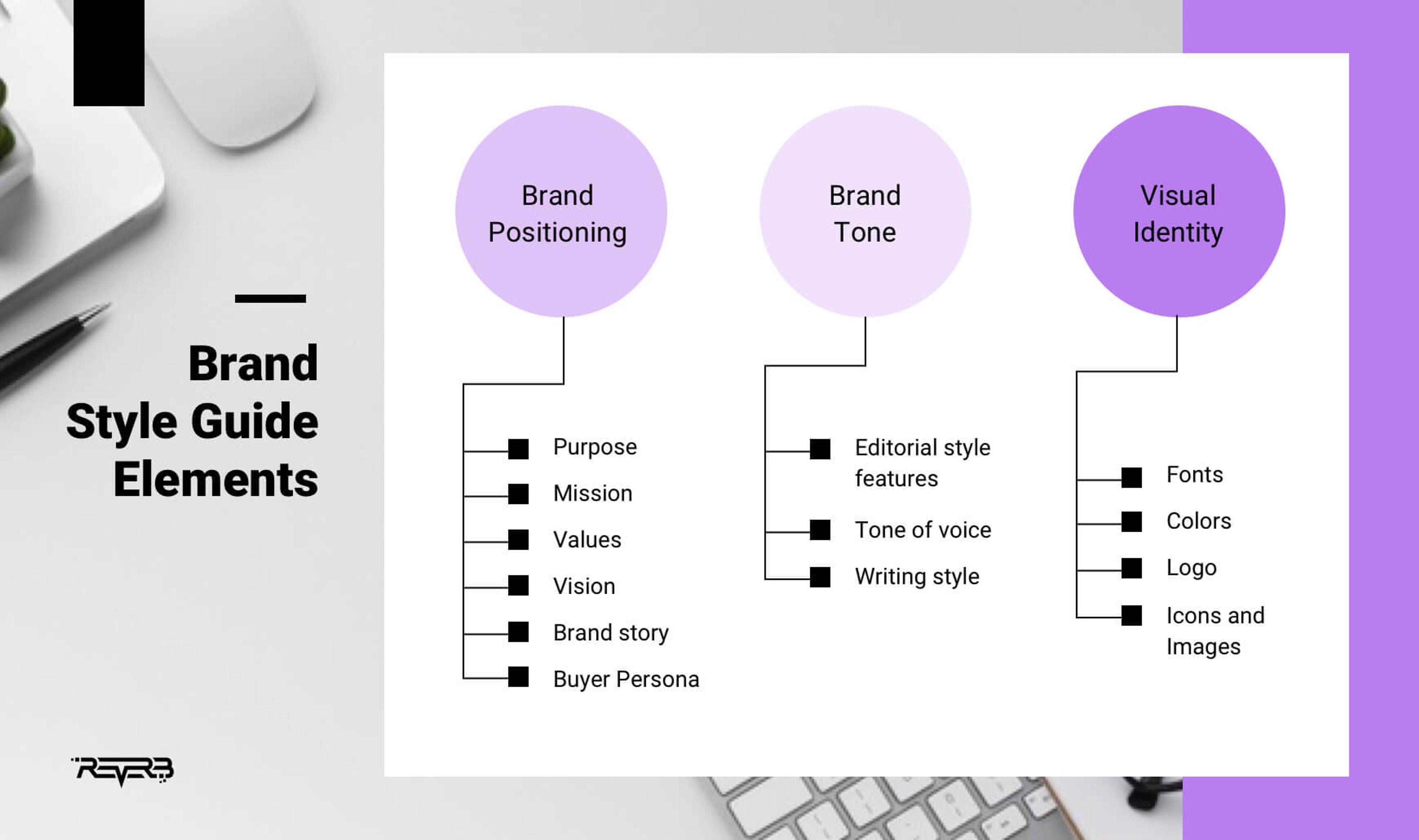In the competitive landscape of modern business, consistency in branding is not just beneficial. It is essential. Brands with a unified image across all platforms are likelier to build trust and recognition among their audience. A cohesive brand identity creates familiarity, leading to customer loyalty and advocacy.
A brand style guide, also known as a brand guide, is a comprehensive document that outlines the key elements of a brand’s identity, including its visual style, tone of voice, and messaging guidelines.
It serves as a roadmap for employees and stakeholders, ensuring that all communications and representations of the brand align with its core values and objectives. This is crucial for businesses of all sizes, as it helps maintain clarity and coherence in branding efforts.
Source: Snowball Digital

Ultimately, a brand style guide is a powerful tool that assists businesses in sustaining brand consistency, establishing a robust identity, and facilitating effective communication with their audience. By adhering to these guidelines, companies can reinforce their value propositions and foster deeper connections with their customers.
What Is a Brand Style Guide?
A brand style guide, often called a brand manual, is a strategic document that delineates the fundamental components of a brand’s identity, ensuring its presentation remains consistent across various channels and platforms. It serves as a reference for employees, designers, and marketers and details how to convey the brand’s message effectively.
Definition and Importance
A brand style guide is more than just a set of rules. It’s the blueprint for your brand’s visual and verbal identity. This comprehensive document outlines how your brand should be presented across all marketing materials and communications, ensuring a cohesive and consistent brand experience.
By defining your brand’s personality, voice, and visual aesthetic, a well-crafted style guide helps to establish a strong brand identity that resonates with your audience. It is vital for maintaining brand consistency and building trust and recognition in the marketplace.
Key Elements of a Brand Style Guide
Visual Identity
- Logo: The primary symbol representing the brand, including variations for different contexts.
- Color Palette: A defined set of brand colors that embody the brand and evoke specific emotions. Consistent use of these colors helps in establishing a cohesive visual presence and enhances brand recognition.
- Typography: Selecting and maintaining fonts that align with the brand’s personality and enhance readability.
- Imagery: Guidelines for photographic and graphic styles that reinforce the brand’s identity.
Source: REVERB

Voice and Tone
This section outlines how the brand communicates with its audience, including the brand voice, language style, formality level, and emotional tone. It guides creators in maintaining the brand’s personality across different messages and platforms.
Other Aspects
- Brand Positioning: A clear statement that defines how competitors and their target audience perceive the brand.
- Core Values: The fundamental beliefs that drive the brand's mission and decision-making processes.
- Mission Statement: A concise declaration of the brand's purpose and the impact it seeks to have in the world.
Why Every Business Needs a Brand Style Guide
Consistency Across Channels
A brand style guide ensures that a brand’s messaging is consistent across all marketing channels, including social media, websites, and print materials, encapsulating the entire brand as recognized by the audience.
By providing clear directives about logos, color palettes, typography, and messaging tone, the guide helps prevent mixed messages that confuse audiences. When businesses maintain uniformity in presentation, they reinforce their identity and ethos, fostering stronger connections with their customers.
Professionalism
A cohesive brand identity conveys professionalism, demonstrating that a business values quality and attention to detail. This consistency in branding builds customer trust, as they are likelier to engage with brands that appear polished and well-coordinated. Professionalism enhances customer perceptions and contributes to a positive reputation in the market.
Efficiency
A style guide significantly enhances efficiency within an organization. Providing standardized guidelines for design and communication reduces the need for repeated decisions and discussions among team members. This clarity allows employees to focus on creativity and execution, streamlining the workflow and ensuring the brand remains on the same page.
Brand Recognition
Consistent branding is vital for helping customers easily recognize a business. When a brand's visual elements and messaging remain uniform, they become more memorable, leading to stronger brand recall. This recognition often translates into customer loyalty, as people are likelier to choose familiar brands when purchasing.
Source: Zoho Show

Employee Alignment
A style guide is also crucial in aligning internal teams with the brand's vision, mission, and values. Providing a clear framework for communication and brand representation fosters a unified company culture where all employees understand and champion the brand's objectives. This alignment not only improves morale but also enhances overall organizational effectiveness.
Adaptability
While a brand style guide offers consistency, it allows for adaptability as the brand evolves. Brands can update or refine their style guide to reflect new ideas, trends, or market realities while maintaining their core identity. This flexibility ensures that a brand can grow and resonate with its audience without losing the essential characteristics that define it.
Key Tips for Creating a Brand Style Guide
Define Your Brand’s Core Elements
Start by clearly articulating your brand's identity, including its core values, target audience, and brand story. This foundation sets the stage for all future branding efforts and ensures that every aspect of your branding communicates a unified message that resonates with your audience.
Design Guidelines
Select a color palette and typography that reflect your brand’s personality and values. Provide logo guidelines on usage, including how it should appear across various mediums, variations for different contexts, and restrictions on alterations. This ensures a consistent visual representation that is integral to maintaining brand recognition.
Source: Looka

Voice and Tone Guidelines
Outline how to define your brand's voice and tone in all communications. This includes specifying the language style (casual, formal, technical, etc.), emotional tone, and vocabulary that aligns with your brand's identity. Consistency here is essential for building a strong relationship with your audience.
Examples of Do’s and Don’ts
Incorporate visual examples that demonstrate acceptable and unacceptable uses of brand elements. Highlighting specific scenarios helps eliminate ambiguity and provides clear guidance on maintaining brand integrity.
Keep It User-Friendly
Design your own style guide to be easy to navigate and understand for both internal teams and external partners. Use straightforward language and logical organization, and consider including a glossary of terms or a FAQ section to clarify any potential confusion.
Update Regularly
Finally, emphasize the importance of periodically revisiting and updating the style guide as your brand evolves. Markets change, audience preferences shift, and staying flexible will ensure that your branding continues to resonate while remaining true to your core identity.
Best Practices for Creating a Brand Style Guide
Creating a practical brand style guide requires careful planning and attention to detail. Here are some best practices to keep in mind:
Make It a Branded Document
Your brand style guide should reflect your brand’s visual identity and tone. The document includes your brand’s logo, color palette, typography, and imagery.
Source: medium

This not only reinforces your brand’s identity but also provides a consistent visual experience for readers. A well-branded document serves as a practical example of your brand guidelines in action, making it easier for internal teams and external partners to understand and apply them.
By following these best practices, you can create a comprehensive and user-friendly brand style guide that ensures brand consistency and helps build a strong, recognizable brand identity.
Examples of Effective Brand Style Guides
Wealth Brand Style Guide
For Wealth, we developed a comprehensive brand style guide that ensured consistency across all platforms. This guide included a well-defined typography system, with a timeless serif for headlines and a clean sans-serif for body text.
Wealth Playbook by Clay
The brand’s color palette was carefully chosen to reflect vibrancy and trustworthiness, balancing fresh green and yellow tones with a grayscale alternative. Additionally, custom illustrations were designed to humanize the platform, providing visual clarity and enhancing the overall user experience. This style guide played a key role in shaping Wealth's cohesive and professional identity.
Coca-Cola’s Brand Style Guide
Coca-Cola is renowned for its iconic brand identity, meticulously outlined in its brand style guide. This guide establishes clear parameters around logo usage, typography, and color schemes that resonate with the brand's core values of happiness and refreshment.
Source: Threads

The consistent use of its classic red and white color palette, alongside the distinct Spencerian script logo, has solidified Coca-Cola's presence globally. Additionally, the guide details the tone of voice, reflecting positivity and connection across all communications.
Online Resources
Several platforms provide valuable insights for those exploring real-world brand style guides. Websites like Brand New and Behance showcase a variety of brand style guides from established corporations and creative initiatives, allowing readers to see how companies articulate their brand identities.
Source: Behance

Additionally, resources such as Canva's Brand Kit provide brand guidelines, templates, and examples that can inspire businesses of all sizes to develop cohesive branding strategies.
Read more:
Conclusion
In conclusion, a well-crafted brand style guide is essential for any organization aiming to establish a strong and cohesive brand identity. By providing clear guidelines on design, voice, and messaging, a style guide helps to foster consistency and recognition across all touchpoints, enhancing customer loyalty and employee alignment.
As brands evolve in response to changing markets and audience preferences, regular updates to the style guide ensure that the brand remains relevant while staying true to its core values.
A thoughtfully constructed brand style guide is a foundational tool for effective branding and a roadmap for future growth and adaptability. Embracing this resource can lead to a more engaged audience and a united team working towards common goals.


About Clay
Clay is a UI/UX design & branding agency in San Francisco. We team up with startups and leading brands to create transformative digital experience. Clients: Facebook, Slack, Google, Amazon, Credit Karma, Zenefits, etc.
Learn more

About Clay
Clay is a UI/UX design & branding agency in San Francisco. We team up with startups and leading brands to create transformative digital experience. Clients: Facebook, Slack, Google, Amazon, Credit Karma, Zenefits, etc.
Learn more


